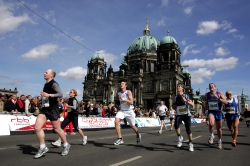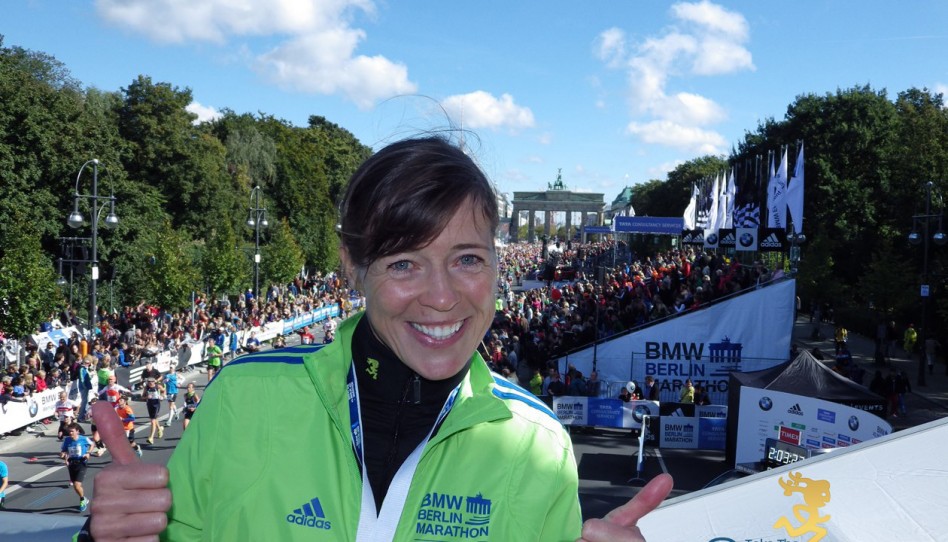Run a Half Marathon in Ten Weeks

A half marathon can be an excellent event. At 13.1 miles (or 21.1K), it is long enough to give you great satisfaction from completing it, and short enough that you can recover quickly after the race. And if you follow a simple half marathon training plan, you can attain your running goals. It is a great stepping stone for runners who plan to move up in distance but who are not yet ready to tackle the marathon.
We would like to share with you two training schedules. The first schedule is better suited for beginning runners whose primary goal is to complete the distance. The second schedule is for more experienced runners, including those whose primary goal is to run the 13.1 miles notably faster than normal training pace.
Guidelines for following the first schedule:
Before you start your half marathon preparation, make sure you are able to run 10 kilometers without having to stop.

The schedule starts with four training sessions per week for the first three weeks. The volume is increased as you extend the distance you run once or twice a week. Please make sure you are well recovered from a fast run before your next hard training session. Also, to avoid injury make light stretching an integral part of your training, preferably after an easy run.
To train properly it is best to increase the speed, both in the context of your overall preparation and within an individual session. For the runs in which you vary the pace, such as when the schedule reads “s-m” or “m-f,” run the first 25% of the distance at a slower pace, than speed up for the middle part of the session, and finish the workout with your fastest effort. See the bottom of the schedule for explanations of the lettering.
One option is to color-code your schedule, the “green” days are your long, easy runs. The “red” days are your harder, faster workouts. Uta used this color-coding method for her workouts throughout her career.
| Week | Mon | Tue | Wed | Thu | Fri | Sat | Sun |
1st | Rest | 10 km (s-m) | Rest | 6 km (m-f) | 8-10 km (s) | Rest | 12-15 km (s) |
2nd | Rest | 10 km (s-m) | Rest | 6 km (m-f) | 10 km (s) | Rest | 15 km (s) |
3rd | Rest | 10 km (s-m) | Rest | 6-8 km (m-f) | 12 km (s) | Rest | 15-20 km (s) |
4th | Rest | 8 km (s) | Rest | 6 km (m) | Rest | Rest | 12-15 km (s) |
5th | Rest | 10 km (s-m) | Rest or 10 km (s) | 8 km (m-vf) | 12 km (s) | Rest | 15-20 km (s) |
6th | Rest | 10 km (s-m) | Rest or 10 km (s) | 8 km (m-vf) | 12-15 km (s) | Rest | 20 km (m) |
7th | Rest | 8 km (s) | Rest | 6-8 km (m) | 10 km (s) | Rest | 15 km (s) |
8th | Rest | 10 km (s-m) | Rest or 8-10 km (s) | 10 km (m-vf) | 10-12 km (s) | Rest | 20 km (s) |
9th | Rest | 10 km (s-m) | Rest | 10 km (s) | Rest | 5 km (f) | 12 km (s) |
10th | Rest | Rest or 8-10 km (s) | 6-8km (s) with 3-4 speed | Rest | 30 minutes easy | 20 minutes easy | HALF MARATHON |
Explanation: s = slow; m = medium; f = fast; sessions of varying pace (s-m or m-f); vf = very fast
Guidelines for following the second schedule:
The same principles apply as for the first schedule. The volume is, of course, higher. Consequently, it is possible to cope with more intense and longer training sessions.
If you are aiming for a particular time, the pace of the steady runs on Thursdays (red) should be between 95% and 100% of your race pace for the half marathon, and those of the faster sessions on Saturdays (red) between 105% and 110%.
Of course, in the build-up you can do shorter races and modify the schedule that at present shows easy training days for Friday and Saturday. If the race is in an easy week, don’t do the fast run on the following Tuesday. Instead, run an easy 15K on that day, and then continue with the schedule. Here too, the “green” days are your long, easy runs. The “red” days are your harder, faster workouts. See the bottom of the schedule for additional explanations of the various workouts in it.
| Week | Mon | Tue | Wed | Thu | Fri | Sat | Sun |
1st | Rest | 12-15 km (m) | 10 km (s) | 8 km (f) | 12-15 km (s) | 8-10 km FL, 8-10 x 100-300 m | 20 km (s-m) |
2nd | Rest | 15 km (m) | 10 km (s) | 8-10 km (f) | 15 km (s) | 8-10 km FL, 8-10 x 100-300 m | 20 km (s-m) |
3rd | Rest | 15 km (m) | 10 km (s) | 8-10 km (f) | 15 km (s) | 8-10 km FL, 8-10 x 100-300 m | 20 km (s-m) |
4th | Rest | 12 km (s-m) | Rest | 8 km (m) | 10 km (s) | Rest | 15 km (s) |
5th | Rest | 15 km of which 6 km (f) | 15 km (s) | 10 km FL | 15 km (s-m) | 5×800-1000m with 3 min Recovery | 25 km (s) |
6th | Rest | 15 km of which 8 km (f) | 15 km (s) | 10 km FL | 15 km (s-m) | 6×800-1000m with 3 min Recovery | 25 km (s) |
7th | Rest | 10-12 km (s) | Rest | 8 km (m) or FL | 10 km (s) | Rest | 15 km (s) |
8th | Rest | 10 km (f) | 15 km (s) | 10 km (s-m) | 8×800-1000m (m-s), 2-3 min Recovery | 10 km (s) | 25 km (s) |
9th | Rest | 10 km (s) | 6-8 km easy FL | 12-15 km (s) | 10-12 km (s) | 8-10 km (f) | 15 km (s) |
10th | Rest | 10 km (s) | 10km (s) of which 5 speedy or 5×800 m | Rest or 8-10 km (s) | 30 minutes easy | 20 minutes easy | HALF MARATHON |
Explanation: s = slow; m = medium; f = fast; FL = fartlek: a popular “free-flow” speed workout with a less structured form of alternating fast and slow intervals, i.e. speedplay, varying in distances on the road or on a trail—ideally not on a track. A typical “off-road” fartlek is one of Uta’s favorite elements of training.
Reading Suggestions:
- How to Use Uta Pippig’s Advice to Become a Better Runner
- Run Your First 5K
- Periods of Training for Your Marathon Preparation and Distance Progression for Your Long Runs
Updated January 14, 2017
Updated November 16, 2016
Updated October 5, 2011
- Posted April 16, 2005
© Copyright 2005-2022 by Take The Magic Step®. All Rights Reserved.




